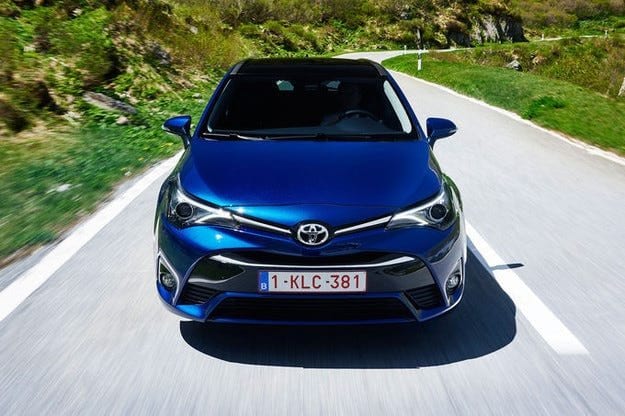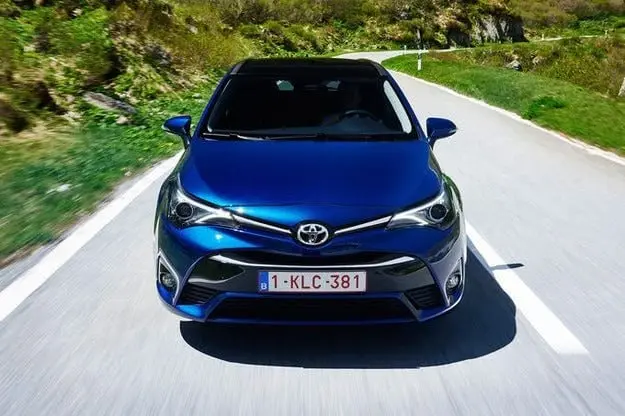
Тест драйв Toyota Avensis 2.0 D-4D: Заточка лезвия

Toyota подвергнуть свою модель среднего класса частичному ремонту. Первые впечатления.
Текущее поколение Toyota Avensis находится на рынке с 2009 года, но похоже, что Toyota продолжает полагаться на него, чтобы добиться более чем приличной доли рынка среднего класса на ряде европейских рынков, в том числе в нашей стране. В 2011 году автомобиль прошел первый фейслифтинг, а в середине прошлого года настало время для второго капитального ремонта.
Более решительное излучение
Даже тем, кто не особо искушается в области автомобилей, обозревателям не составит труда отличить обновленную модель от ее предыдущих версий — передняя часть получила характерные заостренные черты обновленного Auris, для которого характерны небольшая решетка радиатора и осушенные фары. В сочетании с совершенно новым передним бампером с большими воздуховодами это придает Toyota Avensis более современный вид, в котором нет лишних дизайнерских экспериментов — остальная часть экстерьера осталась верной простой и ненавязчивой элегантности. Компоновка спинки имеет более выраженные скульптурные элементы, но не выдает уже привычный стиль модели. Стилистические изменения увеличили длину автомобиля на четыре сантиметра.
Внутри автомобиля мы находим новые, более эргономичные передние сиденья, которые обеспечивают больший комфорт во время путешествия. Как и прежде, здесь достаточно места для пассажиров и их багажа. Многие из тех, что используются для оформления интерьера, стали лучше и приятнее для глаз и на ощупь, а возможности индивидуализации расширились. Помимо ассистента экстренного торможения, ставшего частью стандартного оборудования, модель получила и другие современные решения, такие как полностью светодиодные фары, автоматическое управление дальним светом, ассистент распознавания дорожных знаков, ассистент смены светофоров. кассета.
Лучший комфорт
Модификации шасси были призваны одновременно улучшить ездовой и акустический комфорт, а также поведение Toyota Avensis на дороге. Результат есть — автомобиль идет более плавно и плавно на неровностях, чем раньше, а общий комфорт вождения значительно улучшился. Обратная связь от рулевого управления на должном уровне, и с точки зрения активной безопасности дорожного движения возражений нет — помимо большей комфортности Avensis стал значительно маневреннее, чем был раньше, поэтому работа японских инженеров в этом направлении определенно того стоит. хвалить.
Гармоничный дизельный двигатель немецкого производства
Еще один важный момент в обновленной Toyota Avensis — это дизельный двигатель, который японская компания поставляет из BMW. двухлитровый двигатель мощностью 143 лошадиных силы развивает максимальный крутящий момент 320 ньютон-метров, который достигается в диапазоне от 1750 до 2250 об / мин. В сочетании с превосходно переключающейся шестиступенчатой механической коробкой передач он придает 1,5-тонному автомобилю достаточно хорошего темперамента и гармоничного развития мощности. Помимо сдержанных манер, у двигателя очень скромный аппетит к топливу — стоимость смешанного ездового цикла составляет всего около шести литров на сто километров.
ЗАКЛЮЧЕНИЕ
Помимо более современного внешнего вида и расширенного оборудования, обновленная Toyota Avensis может похвастаться экономичной и продуманной трансмиссией в виде двухлитрового дизельного двигателя, позаимствованного у BMW. Изменения в ходовой части привели к впечатляющему результату — автомобиль действительно стал комфортнее и маневреннее, чем раньше. В дополнение к этому впечатляющему соотношению цены и качества, перспективы этой модели и дальше оставаться в числе ключевых игроков в своем сегменте болгарского рынка выглядят более чем надежными.
Текст: Божан Бошнаков

